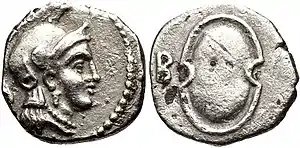Somatophylakes
Somatophylakes (Greek: Σωματοφύλακες; singular: somatophylax, σωματοφύλαξ) were the bodyguards of high-ranking people in ancient Greece.
The most famous body of somatophylakes were those of Philip II of Macedon and Alexander the Great. They consisted of seven men, drawn from the Macedonian nobility, who also acted as high-ranking military officers, holding command positions such as general or chiliarch. Alexander the Great appointed Peucestas as eighth somatophylax after the siege of Malli.
Under Alexander the Great
(Note that this list is speculative in several cases and would be disputed by scholars. For example, Hephaestion was probably not named as early as given below. The only complete list of Alexander's bodyguard in the original sources is found in Arrian (6.28.4), upon the extraordinary appointment of Peucestas in Carmania.)
- 336–334
- 333
- Aristonous, Lysimachus, Peithon, Arybbas, Balacrus, Demetrius, Hephaestion.
- 332
- Aristonous, Lysimachus, Peithon, Arybbas, Menes, Demetrius, Hephaestion.
- 331
- Aristonous, Lysimachus, Peithon, Leonnatus, Menes, Demetrius, Hephaestion.
- 330–327
- Aristonous, Lysimachus, Peithon, Leonnatus, Perdiccas, Ptolemy of Lagus, Hephaestion.
- 326–324
- Aristonous, Lysimachus, Peithon, Leonnatus, Perdiccas, Ptolemy of Lagus, Hephaestion, Peucestas.
- 323
- Aristonous, Lysimachus, Peithon, Leonnatus, Perdiccas, Ptolemy of Lagus, Peucestas.
See also
References
- Heckel, Waldemar. "The 'Somatophylakes' of Alexander the Great: Some Thoughts." Historia: Zeitschrift für Alte Geschichte Bd. 27, H. 1 (1st Qtr. 1978), pp. 224–228.
- Rider, Georges Le (2007). Alexander the Great: Coinage, Finances, and Policy. American Philosophical Society. p. 153. ISBN 9780871692610.
External links
- Somatophylax (Bodyguard) at Livius.org
